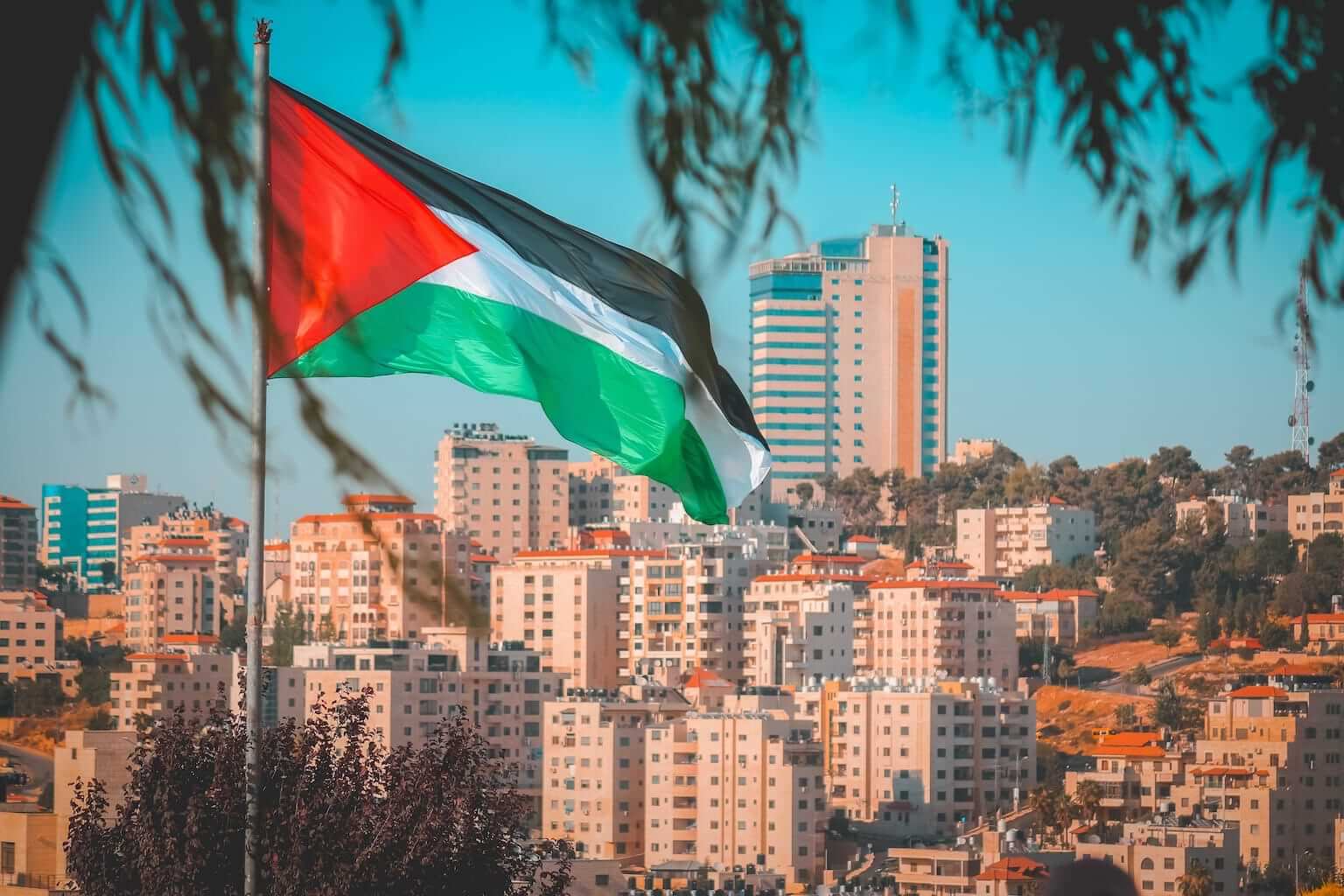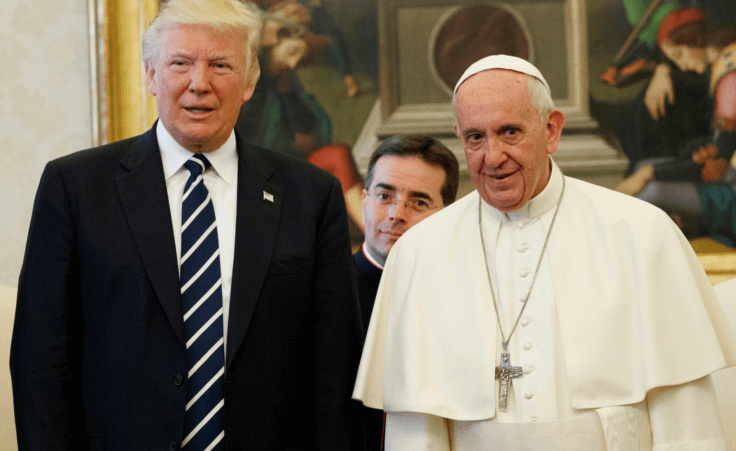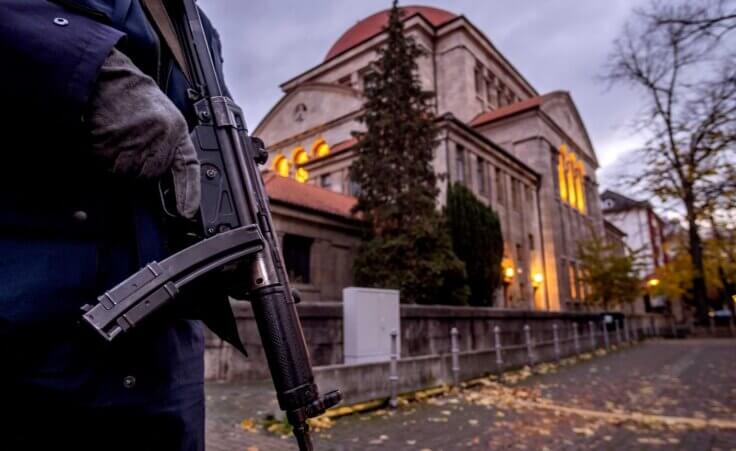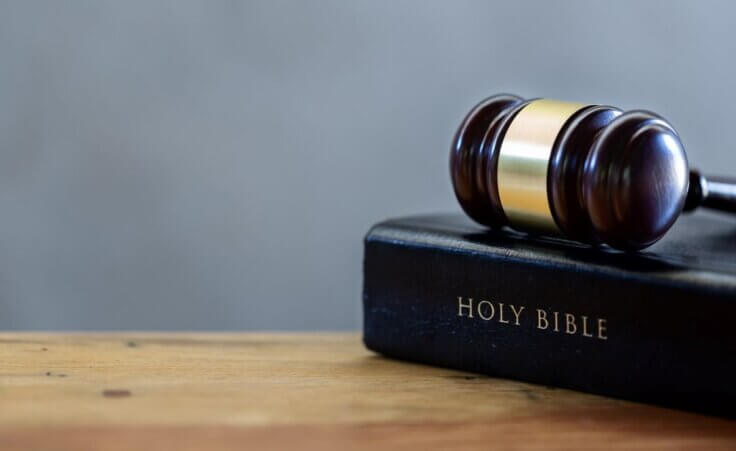
The Palestinian flag flies in front of the West Bank city of Ramallah. By nayefhammouri/stock.adobe.com
The question of how Palestine was formed requires another history lesson.
The Romans continued to rule Palestine from Byzantium, their capital city from AD 324 to 640. However, continued battles with Persia and other political enemies severely weakened the Empire’s military power.
When cavalry swept out of the Arabian desert, motivated by the new Islamic faith preached by Muhammad (AD 570–632), the Empire could offer no resistance. On August 20, 636, at the Battle of the Yarmuk, Palestine fell into Muslim hands. Two years later, the second caliph Omar (AD 634–44), a successor of the prophet Muhammad, accepted the surrender of Jerusalem.
Jerusalem soon became a sacred site for the Muslims and a center of pilgrimage for them. They considered Judaism and Christianity to be their predecessors and thus recognized Abraham, Moses, and Jesus as prophets. In addition, they interpreted the Qur’an to teach that Abraham offered Ishmael rather than Isaac at the top of Mount Moriah where the Jewish temple had been located, which would mean that Ishmael’s descendants—the Arabs—were the true “chosen” people rather than the Jews.
In addition, Muslims believe that Muhammad ascended to God from the Mount Moriah location before returning to Mecca, so they built the Dome of the Rock shrine (AD 691) and the al-Aqsa Mosque (AD 705) adjacent to it. These constitute the third holiest place in Islam after Mecca (the birthplace of the Prophet) and Medina (the place of his death and burial).
Relations with the Christian world were peaceful until 1071, when Seljuk Turks seized Jerusalem and refused to allow Christians to journey there. The resulting frustrations led to the “Crusader Period” (1099–1291), one of the most tragic episodes in Christian history.
The Crusaders recaptured the Holy City on July 15, 1099. Their first act was to massacre all the Muslim inhabitants. They continued their war against the Muslims until they were defeated by the Mamluks from Egypt. Buildings dating to the Crusaders are common in Jerusalem today.
From 1250 to 1517 the Mamluks from Egypt controlled Palestine, later ceding power to the Ottoman Turks (from Turkey, hence the name). Suleiman the Magnificent (1520–66) rebuilt the walls of Jerusalem; his work is still evident throughout the city today. But the Turks sided with Germany in the First World War and the victors dismembered their empire. The British were given control of Palestine, ushering in the “British Mandate” period.
NOTE: This resource article belongs to a series regarding the foundational issues behind the ongoing war between Israel and Hamas. The full series is also available as a free ebook.
Jews in the land
Even after the Romans renamed the region “Palestine” in the second century and deported many of the Jews, there remained a strong Jewish presence in the land, so much so that they staged another revolt against a corrupt Roman governor in AD 351–2. A short-lived attempt to rebuild the temple in Jerusalem was made under Emperor Julian (AD 361–3), but an earthquake and Julian’s death ended the effort.
After Arab Muslim invaders conquered the land in AD 640, both Arab and Jewish communities multiplied in Palestine. However, by the end of the eleventh century, the Jewish population had declined significantly, though large Jewish communities remained in Hebron, along the coast, and in areas of Galilee. Tragically, the Crusaders (AD 1099–1291) massacred many of the Jews in Palestine and restricted them from land ownership, though they maintained a large presence in the area, especially in Galilee.
Under the Mamluks, Jewish presence shrank to an estimated five thousand people. However, under the Ottomans, Palestine saw a resurgence of Jewish life and a repopulation of the land. Throughout the nineteenth century, Jews from Eastern Europe and from Turkey, Bulgaria, and North Africa began immigrating in great numbers to the region. Large waves of settlers followed in the late nineteenth and early twentieth centuries.
By 1947, there were approximately 630,000 Jews living alongside 1.2 million Arabs in Palestine. That year, the United Nations adopted a Partition Plan whereby the West Bank (the area along the west bank of the Jordan River and the Dead Sea, slightly smaller than the state of Delaware) and the Gaza Strip (on the southwest Mediterranean coast, twenty-five miles long and four to seven-and-a-half miles wide) would become the autonomous nation of Palestine for the first time in history. The remaining section in the middle would become the State of Israel.
Jewish leaders accepted this plan, but Arab leaders rejected it. When Israel was declared a nation in 1948, armies from Egypt, Lebanon, Syria, Jordan, and Iraq marched into the territory, launching Israel’s 1948 War for Independence.
In a brilliant 1973 article for Foreign Affairs, then-Israeli Prime Minister Golda Meir wrote that her people “brought to fruition the labor of Jewish pioneers who, since the turn of the century, gave their lives to transform a barren and denuded land into fertile fields, flourishing settlements, and new patterns of society.” The land they rebuilt “had neither oil nor abundant natural resources. Its wastes offered no temptation except to Zionist pioneers animated by the twin ideal of a new Jewish society and a reconstructed land.”
Arabs in the land
When the 1948 war began, Arabs living in Palestine were encouraged by their leaders to flee to the West Bank and Gaza for what they were assured would be a brief conflict after which they would be permitted to return to their homes. More than seven hundred thousand did so; a third went to the West Bank, a third to the Gaza Strip, and the rest to Syria, Jordan, Lebanon, and other countries, while around 156,000 chose to remain.
Israel won the war, controlling land it would have received under the Partition Plan, while the West Bank remained under Jordanian control and the Gaza Strip was controlled by Egypt. Jewish migration into the new nation grew significantly. Today, the State of Israel numbers nine million, seven million of whom are Jews; the other two million are Arabs descended primarily from those who stayed in the land in 1948. Another three million Arabs live in the West Bank and two million in the Gaza Strip.
In the 1967 war, Israel gained control of the West Bank and Gaza Strip. This brought about a second exodus of Palestinians, estimated at half a million. In 1993, the Palestine Liberation Organization (PLO) accepted Israel’s right to exist; in return, Israel supported the creation of a Palestinian Authority (PA) to assume governing responsibilities in the West Bank and Gaza Strip.
In 2005, Mahmoud Abbas, the leader of Fatah (the majority party within the PLO) was elected president of the PA. That same year, Israel withdrew its armies and settlers from Gaza.
The next year, a rival party named Hamas (to be discussed in Chapter 5) won legislative elections but refused to recognize Israel’s right to exist. In 2007, Hamas gained control of Gaza, while Fatah retained control of the West Bank. From then to today, the two rival parties have each claimed to lead the Palestinian people and cause.
Complicating matters further, numerous Jewish settlements have been built in parts of the West Bank, though they do not represent the State of Israel.













